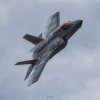Puola sanoi EI kumppanuudelle. Syynä n. 1 USD miljardin säästö ja se että kumppanuusohjelman alihankintaketju sekä depotit on jo jaettu. Uudet toimijat eivät tule saamaan siivuakaan hankintaketjussa, jollei Turkin poisjääminen saattaisi tarjota jotakin. Turkki valmistaa osia koneisiin maaliskuuhun saakka, kunnes sopimus päättyy.
Poland to Resign from the F-35 Offset to Save USD 1 Billion [EXCLUSIVE]
20 grudnia 2019, 09:16
Polish Ministry of Defence recommended it to the Offset Committee to resign from concluding the offset agreement pertaining to F-35 acquisition within the framework of the Harpia programme - Defence24.pl found out. The proposals submitted by the US partners did not match the Polish requirements and they would entail too high cost - Col. Jacek Najs claims - acting as the Director at the Offset Agreements Bureau of the Polish Ministry of Defence.
The MoD recommends that Poland shall resign from concluding the offset agreement related to the F-35. The final opinion on the matter is to be released after a vote, during the upcoming meeting of the Offset Committee expected in January. Stance adopted by the MoD remains unchanged though. “This will be a new global system of spare parts supply and keeping this aircraft in operations”, explains Major General, Pilot Jacek Pszczoła, the Air Force Inspector and plenipotentiary for acquisition of the new generation fighter aircraft.
“We have presented our recommendation, that is suggesting we should resign from concluding the offset agreement. We want to focus on industry-industry memorandums that shall be signed in the future, similarly as it happened in case of the agreements signed with regards to the Belgian aircraft”, the representatives of Ministry of Defence, told us. “Preliminary talks on that matter have already begun, but at the moment we cannot release any further details for now. Potential conclusion of agreements as such will not be correlated with procurement of the F-35, however, it would happen sooner than later.”
Resigning from the offset is to make it possible to save up more than one billion dollars, however it may also take away the opportunity for the Polish industry to acquire high tech, despite the high level of the fighter-associated expenditure (at least 4 billion dollars).
When asked about the above circumstances, the MoD representatives told us the following: “Proposals that we have received have not been adequately meeting the Polish requirements, furthermore they did not satisfy Poland considering the cost-effect ratio. We should remember the fact that offset does not come without a pricetag. We knew that not being a participant of the F-35 programme it would be much tougher for us to gain capabilities of any sort - be it manufacturing or maintenance - with regards to that aircraft. That chance went away back in 2008 when Poland was offered a chance to join the programme as an observer. However, the proposal in question has been rejected. Should it be otherwise, the position to negotiate would be much stronger today.”
Representatives of the MoD also stress the fact that the recommendation has not been adopted on one side by the Ministry, it has rather been adopted after consultation with the Polish industry, research institutes and the academia.
“It was more or less at the time when the plenipotentiary for the acquisition of the Multi-Role Combat Aircraft was appointed, in March 2019, when the preliminary analysis has begun” – col. Jacek Najs recalls – “We have been working on defining a catalogue of capabilities required from the point of view of the requirements defined by the military within the scope of operating the F-35. The preparatory work, issuing opinions with regards to the potential areas of cooperation or offset took place between May and July, with involvement of the Polish Military, the PGZ Group, military-focused institutes and the academia. And this is how the preliminary scope of commitments has been defined.
In the meantime the Americans proposed a scope of maintenance and repair activities. However, as we have noted, their proposals were limited to the level that would be guaranteed anyway, within the framework of the delivery agreement. These were the facilities at the airbase level. Obviously, we came to a conclusion that this does not match our requirements and that we need to look for something else.
Then, we tried to have a look at the offset matter from a broader perspective, perceiving it as a broadly-understood air defence system, reaching beyond the areas related to the jet. At the same time, we could not have left the area directly tied to the F-35 as the offset is not a tool of compensation and, in line with the law, it needs to be directly associated with the subject of acquisition.”
“Having a look at the specifics of the F-35 programme, one needs to say that it is a closed programme. Nine members of the programme have already divided the supplies and manufacturing market. We have a factory in Camari, Italy, where the F-35 is assembled now, with D-level maintenance also expected to be available in the future, up to the factory level. Meanwhile, advanced works on the engine are taking place in the Netherlands.
Entering this area would be challenging to say the least. It would not be as cost-effective as expected”, col. Najs said.
The Poles were also considering obtaining capabilities regarding the F-35 logistic support system. However, this is also where modern character of the undertaking has turned out to be an obstacle. “Logistics support system for the F-35 is of specific nature. It very much differs from what we have been experiencing so far. GSS and ALIS systems at the base of the logistics supply chain that have been adopted by the US and by the remaining members of the programme are globally unified -
breaking the facade now and establishing maintenance and repair capabilities in Poland, outside the system, would be impossible”, Najs claims.
https://www.defence24.com/poland-to-resign-from-the-f-35-offset-to-save-usd-1-billion-exclusive

 )
)




 .
.